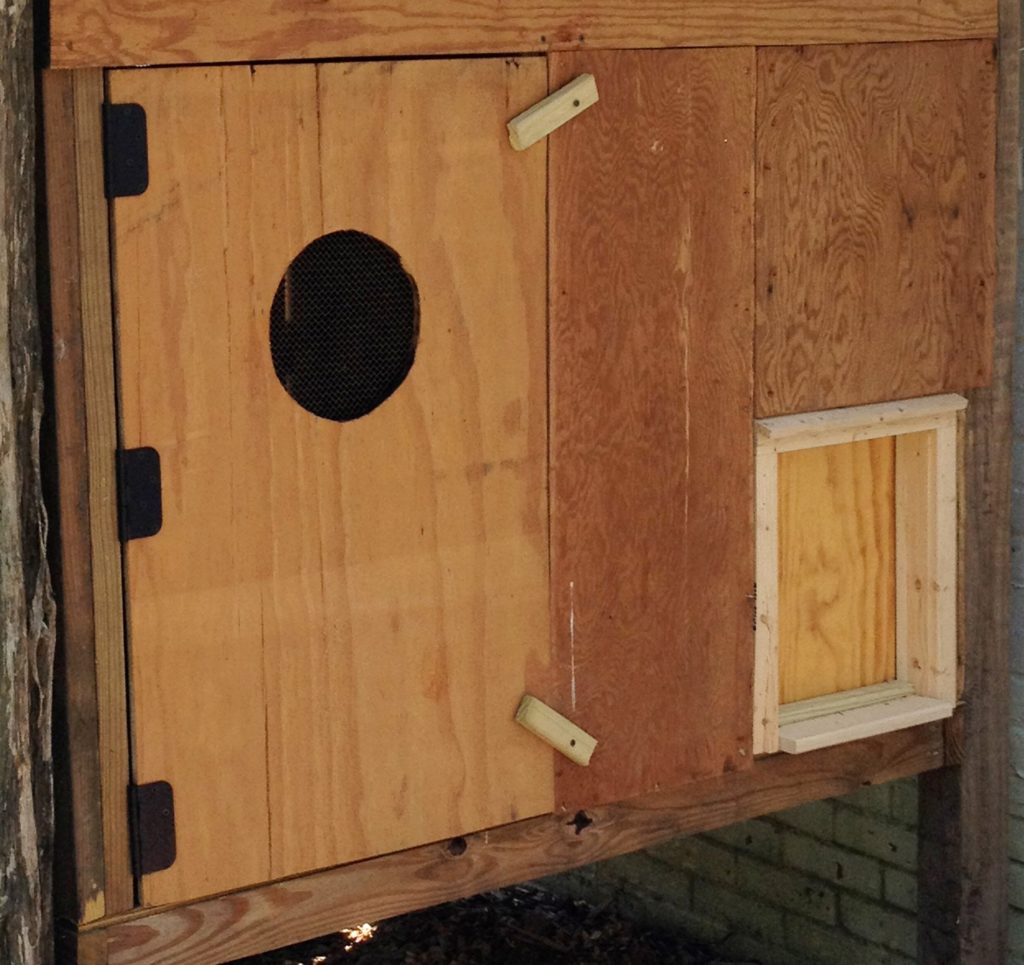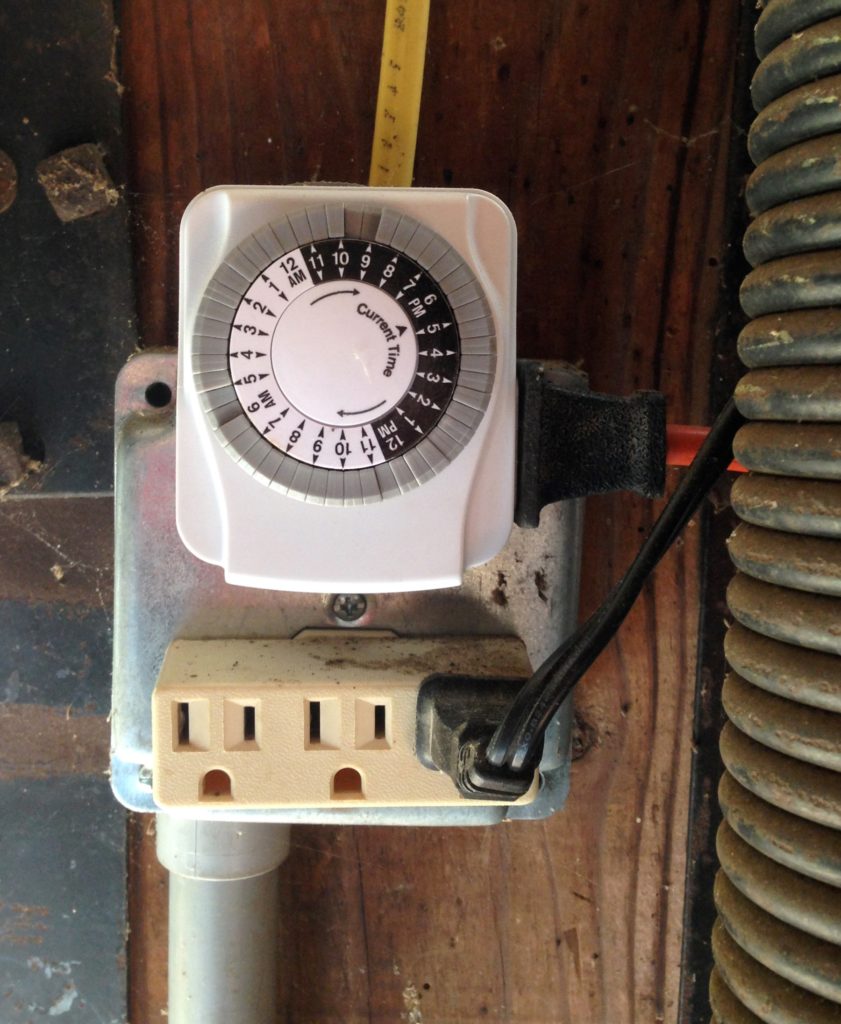Open Sesame: Coop Doors that Open on Command
Frank Hyman knows about DIY and being inventive. Here are some of his ideas for automatic chicken coop doors.
The Basic Pop-Door
One important goal for our chicken-keeping adventure was to continue enjoying two-week vacations a couple times a year. However, one common feature of most coops promised to interfere with that goal: the pop-door. This is the small door on a coop that allows hens to go out at dawn to forage, scratch, and get a good dust bath. At night, the pop-door is closed after the hens settle in for the evening, providing added security against nighttime predators, including raccoons, opossums, weasels, and coyotes. In the morning, it needs to be opened again so the chickens can start another day of socializing and feasting.

A closed automatic pop-door on the right; closed keeper access door on the left. Photo by author.
The simplest version I’ve seen is to put a couple hinges on the top of the gangplank and a hook at the bottom. After the girls go in for the evening, just lift the gangplank to cover the door opening and secure it with the hook. It’s a good design, but it’s still a twice-a-day chore that’s not compatible with vacationing — or even sleeping in.
Chris and I are compatible in many ways. One of them being that we both believe in “early to bed and late to rise.” In other words, it’s been a long time since either of us has seen the sunrise.
We considered three ways to resolve this quandary, and you may want to choose one of these.
- Manual Pop-Door. In the old days, when the backyard sufficed as the chicken yard, this twice-daily ritual was necessary to keep predators out of the coop. But for modern hen keepers, if you’re confident that the fencing of the hen pen is secure against predators, then you could actually forgo an operating pop-door. After all, if the pen is well made, the pop-door is just a second layer of security. An opening big enough for the hens to come and go freely would only need to be about 8 inches by 12 inches.

Pop-door open, so chickens can get at a load of grass clippings. Photo by author.
- A chicken-activated door seems ideal to me. This guy, Andrew Wells in England, appears to have figured it out. Watch his video on YouTube and read his comments at http://tinyurl.com/zayycpg. When all the chickens have climbed on the roost, their combined weight shifts the roosting bar so that cables and pulleys lower the pop-door. When they hop off the roost, their weight shifts again and opens the pop-door in the morning. The counter-balancing milk jugs, partly full of soil, weigh just a bit less than the chickens. This system is adjustable to allow for changes in chicken population (and weight). Just add or pour out some soil to get the balance right. It’s on my list to put something together like this, but it may be a while before I get to it. If you build one first, let me know.
- Automatic coop doors that are available online. This is the route we chose. There are several designs on the market, but they all cost about $200 or more. Chris said she was more than happy to pay if it meant we could wake up in a leisurely way while listening to the happy clucking of hens in their pen.
If you go this route, all the doors on the market come with decent installation instructions and videos. That being the case, there’s no sense addressing each one here. Instead of duplicating their efforts, let me share my thoughts on your several decision points when it comes to choosing an automatic door.
Sunshine or Fossil Fuels?
Or in practical terms, solar-powered or hard-wired? If you already have electric power going to your coop, then you may want to forgo the extra expense and time of installing a solar panel to run your automatic door. We didn’t have power running to our coop, but it was next to the brick wall of our garage, which does have power. I used a masonry bit and a hammer-drill (they can be rented) to drill a hole through the brick wall and run the electric cord from the automatic door into the garage where I plugged it into an outlet. Some people may want to run an extension cord outside from their house to the coop, but you’re taking a chance on an electrical short during rainy weather, so make sure the cord is plugged into what’s called a GFCI outlet. That means that if there’s a short in the cord, the outlet will turn off rather than setting a fire in your house. An electrician can switch out an old outlet for a GFCI. Also, be sure you’re using a cord rated for outdoor use. And if the connection point is exposed to the weather, cover it with a plastic clamshell made to keep water out of cord connections. They only cost a few dollars.
On the other hand, if it would be troublesome to run power to your coop, then solar may be just what you want. A solar panel is also immune to power outages. But you’ll need more than the solar panel mounted on or above the coop. The energy from the solar panel will need to pass through a converter and be stored in a 12-volt battery. It’s the battery that’s connected to the automatic door. And you’ll need a light sensor tied in so the door will open at dawn and close at dusk.
Hinges or Cables?
Should you get a coop door that opens on hinges, like traditional versions, or one that’s raised up and down by a wire on a spool, similar to how a window shade works? We didn’t look at very many reviews of coop doors. “How different could they be?” we thought. We picked one that had a good installation video on their website, and it’s worked fine for seven years. But because it’s the kind that’s pulled up by a wire, I anticipate that at some point the wire will break and it could be time-consuming to repair. If I had to do it over again, I think I’d go with the door that swings open on hinges, or perhaps one that’s lifted by a rod. Why? Because a chain is only as strong as its weakest link, and a thin wire in constant motion might be that weak link.

Hinges allow the door to fold up easily. Photo by author.
What About the Bedding?
Both opening styles share a potential problem. If bedding gets in the doorway, the door won’t close all the way. If a raccoon gets through the fencing, it could grab the exposed edge of the door and open it. So, we positioned a foot-long length of 1 x 4 on the floor, inside the doorway, as a shield to keep the bedding from blocking the opening.
Make Time for a Timer
All the automatic doors that I’m aware of depend on the common timer that turns living room lamps on and off while you’re away. You simply set the off and on times according to the instructions, plug the automatic door’s cord into the timer, plug the timer into the outlet, and you’re all set to go on a road trip.

A timer inside the garage. The orange cord on the right is plugged into the automatic door. Photo by author.
Unless the power goes out
If the power goes out, the door will stay in whatever position it’s in—open or closed. If it goes out overnight, then the chickens will stay sequestered in the coop until you either prop the pop-door open, prop open the keeper door, or are able to reset the timer when the power returns. This is the one downfall of automatic doors — and a good selling point for using a solar panel, as mentioned above. If this happens while you’re out of town, it may be tricky to get a neighbor to reset the timer, as the process is a bit counter-intuitive (so consult the instructions!). We had to learn this lesson the hard way. Since then, for our out-of-town trips, we turn the door off and leave it open, so the chickens can come and go freely. Since we have a predator-proof pen, we don’t worry about their safety.
Cover Up Any Tasty-Looking Wires
After you install the door according to the provided instructions, there may be some visible wires that would be tempting for the chickens to peck at. I could see that was the case with ours.

Interior of the coop; brown, triangular piece of plywood covers the exposed wires above the automatic coop door. Photo by author.
To be on the safe side, I screwed a scrap piece of plywood over the wires in a way that wouldn’t interfere with the operation of the door. Because I used screws, I can always remove the plywood if I have to replace or work on the automatic door. But I don’t have to worry about our birds shocking their tender chicken lips if they mistake a wire for a worm.
Frank Hyman is the author of Hentopia: Create Hassle-Free Habitat for Happy Chickens; 21 Innovative Projects.













5 Comments
I have one of those $200 auto doors. it slides down and then at night the raccoons come and lift it up it up go inside and kill my hens. The door is light wt set on a timer. We use to shut if we are going to be home after dark. Then I go up and close the wood door. I would not buy one again
You can stop the raccoons by putting a wooden strip in front of the bottom of the door. Just a 2″x2″ or similar piece of wood. With that style of door you need to make it so they can’t slip their fingers under the edge of the door. A strip of wood will do that and keep your chickens safe. Good luck!
Also, it’s important to have a pen that keeps critters out: 1) fence wire, not chicken wire. 2) the same kind of wire over the pen, so they can’t climb into the pen, 3) an “apron” of fence wire around the base of the pen fencing so they can’t dig under the fence and 4) bricks laid under the gate as an “unwelcome mat” so they can’t get under it. Can find details on how even non-carpenters can build these simply structures in my Hentopia book. Good luck!
We got an automatic door opener 11 years ago and it was the best $100 we’ve ever spent. What a luxury. Our “door” is the kind that slides up and down in a track on the inside of the coop and there is a sill on the outside of the door that covers the bottom of the door so prying hands can’t get a grip. The door itself is a white plastic cutting board with a hole as the handle. This is where the thin cable (not wire) is connected and it is controlled with a timer. Works like a charm and we don’t have to worry about a wood door warping or swelling with moisture. Every chicken keeper needs this.
Who did you purchase your automatic door opener from?